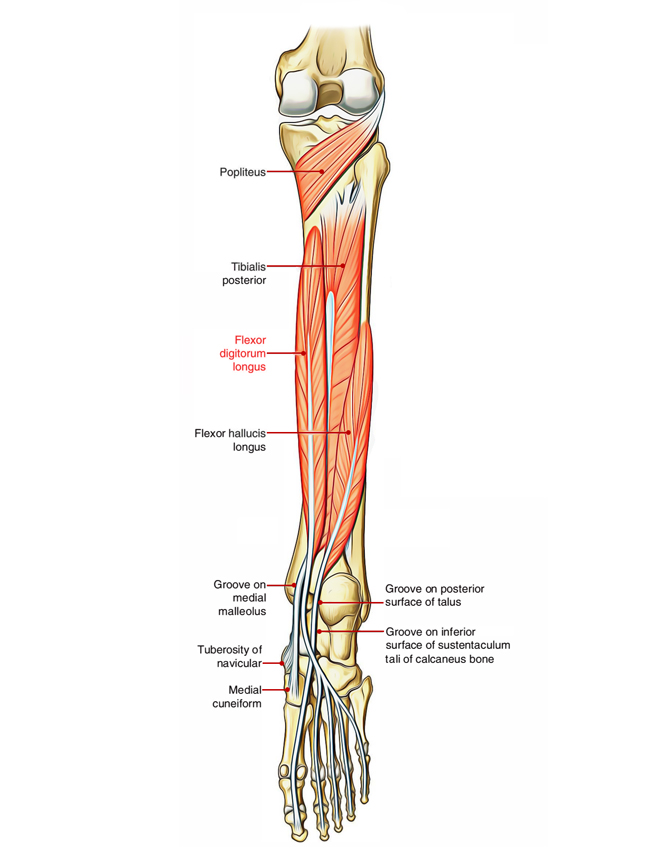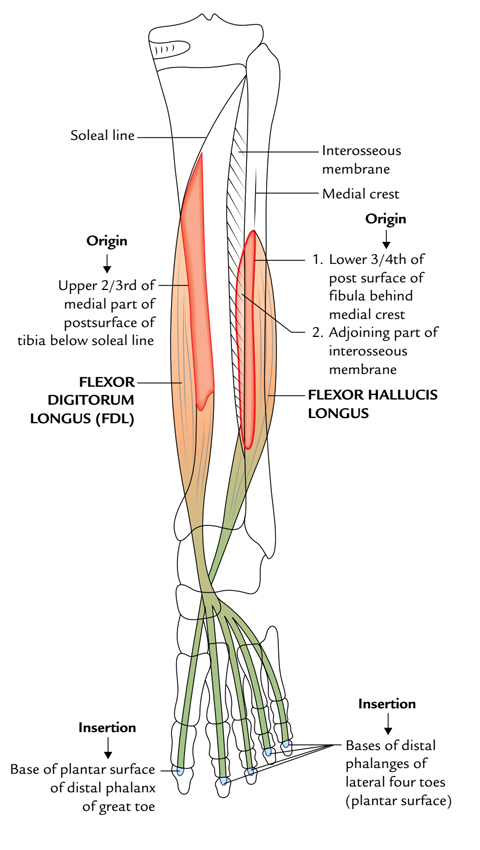Flexor digitorum longus muscle is a bipennate muscle which occurs through both bones of the leg. Its tibial origin is through the posterior side of the bone below the soleal line, however, because of the inter-muscular septa in this region, it can also be revealed to develop through the fibula by a wide aponeurosis whose oblique fibers are changed by flesh to form the lateral half of the bipennate muscle.

Flexor Digitorum Longus
Structure
- The tendon create centrally in the bipennate mass as well as descents downwards throughout the tendon of tibialis posterior in the lower part of the leg.
- The tendon moves underneath the flexor retinaculum and gets in the sole of the foot, and intercrosses the tendon of flexor hallucis longus. At this moment it splits into four tendons, the medial two which get a strong slip through the tendon of flexor hallucis longus.
- The four tendons at their beginning get the insertion of the flexor accessorius muscle. More distally each offers origin to a lumbrical muscle.
- The tendons enter the fibrous flexor sheaths of the lateral four toes, bore the tendons of flexor digitorum brevis, and are placed into the bases of the distal phalanges.

Flexor Digitorum Longus: Origin and Insertion
Innervation
The flexor digitorum longus gets fibers through a section of the tibial nerve.
Function
- The flexor digitorum longus muscles work throughout walking to support the foot along with ankle in midstance to late position, contributing in mediolateral balance.
- It helps other plantar flexors in making it possible for the it to move weight to the forefoot, as well as they assist in keeping the balance when weight is on the forefoot.
- The flexor digitorum longus bends the distal phalanx of each of the four lesser toes.
Activities
- The flexor digitorum longus along with the flexor hallucis longus act mostly as flexors of the distal phalanges of their particular toes along with essential additional activities of helping plantar flexion along with inversion of the foot.
- The middle and also proximal phalanges might quickly be elongated. Direct electrical activation of the flexor digitorum longus muscle with the limb totally free caused powerful flexion just of the distal phalanges of the four lesser toes.
Injury
One can also hurt the flexor digitorum longus muscle while operating on a beach in the sand with no shoes making the muscle susceptible for traumas. Flexor digitorum longus trauma can accompany a journey and fall on irregular side when the toes are unable to grip the side absolutely.
In case of flexor digitorum longus pain or strain, the patient will discover it difficult to walk and also will have unbearable pain in the feet along with ankles. Support splints in addition to warm compresses are the most favored method of dealing with flexor digitorum longus pain or strain.
Clinical Significance
Throughout the propulsion stage of walking, running or leaping, flexor digitorum longus pulls the toes down to the ground to achieve optimum grip and thrust throughout toe-off. Throughout standing the muscle helps with balance by grasping the ground. Fractures of the sustentaculum tali can trigger entrapment of the flexor hallucis longus or flexor digitorum longus tendons among other problems that might show plastic surgery.
Post-operative management consists of making use of a lower leg splint for 5-7 days, fractional weight-bearing with 20 kg for 6-8 weeks in the patient’s own shoes, early series of motion workouts of the ankle, subtalar and mid-tarsal joints. Results are normally great with those sustaining separated fractures carrying out much better.

 (52 votes, average: 4.84 out of 5)
(52 votes, average: 4.84 out of 5)